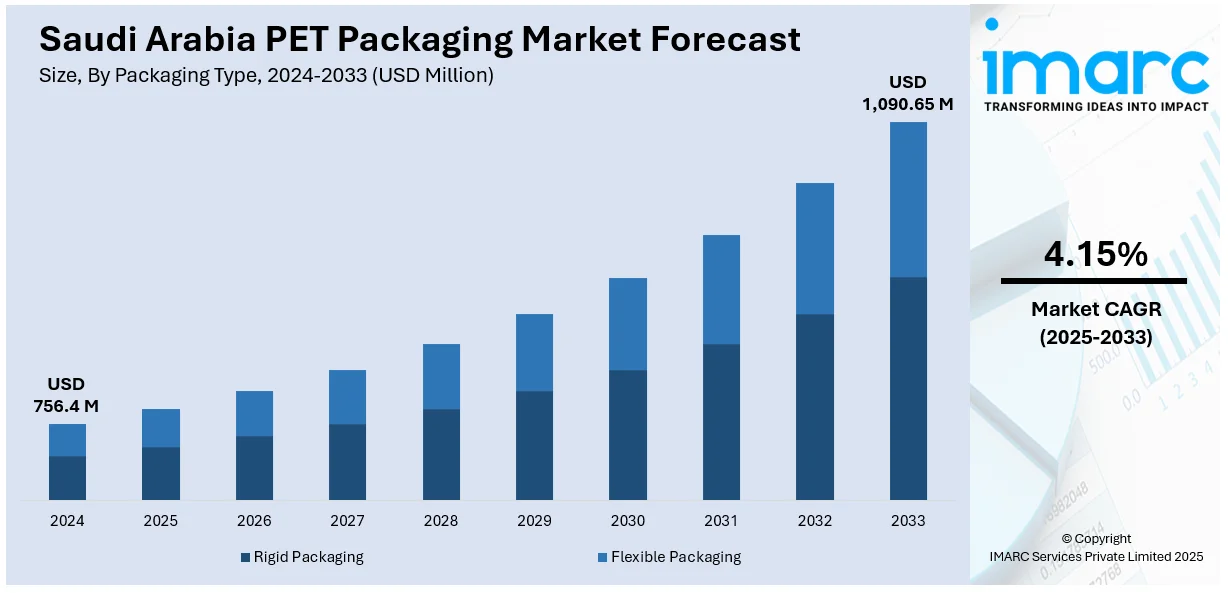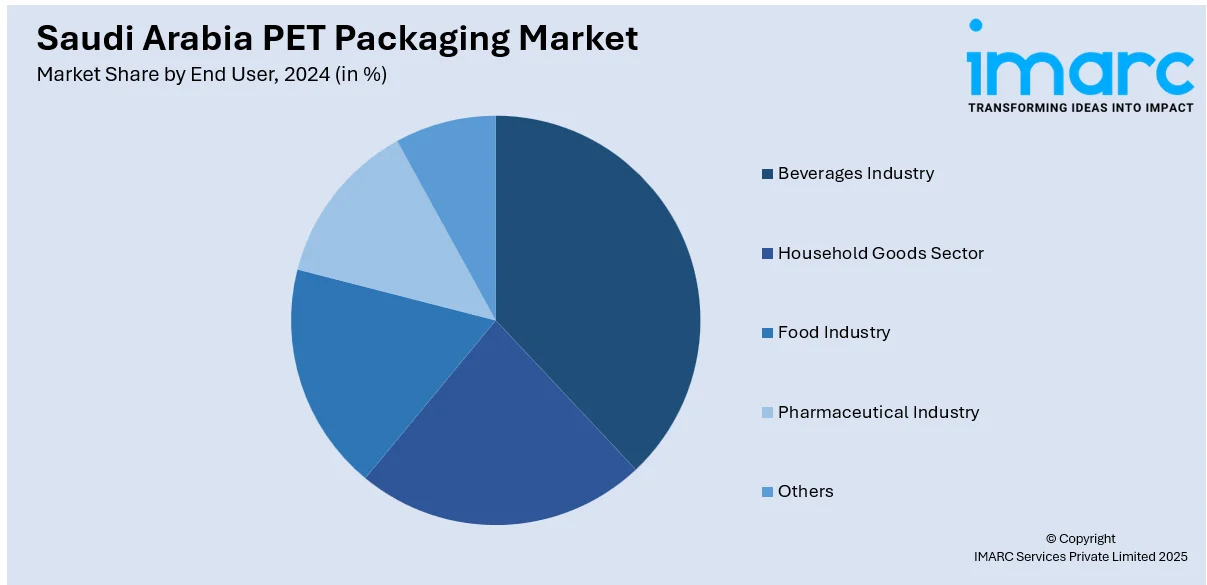
Saudi Arabia PET Packaging Market Size, Share, Trends and Forecast by Packaging Type, Form, Pack Type, Filling Technology, End User, and Region, 2025-2033
Saudi Arabia PET Packaging Market Overview:
The Saudi Arabia PET packaging market size reached USD 756.4 Million in 2024. Looking forward, IMARC Group expects the market to reach USD 1,090.65 Million by 2033, exhibiting a growth rate (CAGR) of 4.15% during 2025-2033. Rising demand in food and beverage sectors, increasing urbanization, growing consumer preference for lightweight and recyclable materials, government initiatives for sustainability, and expansion in pharmaceutical and personal care industries, boosting packaging innovation and PET usage across sectors, are some of the factors contributing to the market growth.
|
Report Attribute
|
Key Statistics
|
|---|---|
|
Base Year
|
2024 |
|
Forecast Years
|
2025-2033
|
|
Historical Years
|
2019-2024
|
| Market Size in 2024 | USD 756.4 Million |
| Market Forecast in 2033 | USD 1,090.65 Million |
| Market Growth Rate 2025-2033 | 4.15% |
Saudi Arabia PET Packaging Market Trends:
Expansion of Local Manufacturing Capacity
The PET packaging sector in Saudi Arabia is experiencing a shift toward localized production, with significant investments being made in advanced molding facilities. New setups are incorporating blow molding and injection molding technologies to cater to rising domestic demand. These facilities are enhancing self-sufficiency in PET-based packaging products, reducing reliance on imports. The expansion also reflects broader industrial goals focused on scaling up plastics manufacturing and integrating modern production lines tailored for packaging applications. These factors are intensifying the PET packaging market growth. For example, in June 2024, APICO inaugurated a new factory in Al-Kharj Industrial City, marking a key expansion milestone. The facility spans 34,000 square meters and includes advanced blow molding and injection molding lines. As part of its growth plan, APICO confirmed the addition of PET product manufacturing, supporting the domestic PET packaging supply in Saudi Arabia and reinforcing its capabilities in plastics production.

Strengthening rPET Export Capabilities
Based on the PET packaging market outlook, Saudi Arabia is stepping up as a competitive supplier of hot-washed recycled PET flakes to international packaging manufacturers. With rising global demand for sustainable packaging inputs, local recycling operations are gaining momentum, supported by national sustainability objectives and circular economy goals. The focus on producing export-grade recycled materials is driving improvements in quality standards and positioning domestic recyclers as credible contributors to global supply chains. This shift not only enhances the country’s recycling capacity but also builds a foundation for broader industrial participation in environmentally responsible packaging solutions, reinforcing Saudi Arabia’s role in the evolving global movement toward resource efficiency and reduced plastic waste. For instance, in January 2024, MASAB, a joint venture of the Saudi Investment Recycling Company, exported hot-washed recycled PET flakes to a leading UK bottle manufacturer. This followed earlier shipments to Spain, totaling over 1,650 tons. The initiative supports Saudi Arabia’s PET recycling capabilities and aligns with national sustainability goals by advancing local industry participation in global recycled PET packaging supply chains.
Saudi Arabia PET Packaging Market Segmentation:
IMARC Group provides an analysis of the key trends in each segment of the market, along with forecasts at the country and regional levels for 2025-2033. Our report has categorized the market based on packaging type, form, pack type, filling technology, and end user.
Packaging Type Insights:
- Rigid Packaging
- Flexible Packaging
The report has provided a detailed breakup and analysis of the market based on the packaging type. This includes rigid packaging and flexible packaging.
Form Insights:
- Amorphous PET
- Crystalline PET
As per the PET packaging market forecast, a detailed breakup and analysis of the market based on the form have also been provided in the report. This includes amorphous PET and crystalline PET.
Pack Type Insights:
- Bottles and Jars
- Bags and Pouches
- Trays
- Lids/Caps and Closures
- Others
The report has provided a detailed breakup and analysis of the market based on the pack type. This includes bottles and jars, bags and pouches, trays, lids/caps and closures, and others.
Filling Technology Insights:
- Hot Fill
- Cold Fill
- Aseptic Fill
- Others
The report has provided a detailed breakup and analysis of the market based on the filling technology. This includes hot fill, cold fill, aseptic fill, and others.
End User Insights:

- Beverages Industry
- Bottled Water
- Carbonated Soft Drinks
- Milk and Dairy Products
- Juices
- Beer
- Others
- Household Goods Sector
- Food Industry
- Pharmaceutical Industry
- Others
A detailed breakup and analysis of the market based on the end user have also been provided in the report. This includes beverages industry, (bottled water, carbonated soft drinks, milk and dairy products, juices, beer, and others), household goods sector, food industry, pharmaceutical industry, and others.
Regional Insights:
- Northern and Central Region
- Western Region
- Eastern Region
- Southern Region
The report has also provided a comprehensive analysis of all the major regional markets, which include Northern and Central Region, Western Region, Eastern Region, and Southern Region.
Competitive Landscape:
The market research report has also provided a comprehensive analysis of the competitive landscape. Competitive analysis such as market structure, key player positioning, top winning strategies, competitive dashboard, and company evaluation quadrant has been covered in the report. Also, detailed profiles of all major companies have been provided.
Saudi Arabia PET Packaging Market News:
- In August 2024, the Saudi Investment Recycling Company (SIRC) exported its first recycled and heat-washed PET flakes to a major UK recycled PET bottle manufacturer. This followed earlier shipments to Spain, marking a significant step in SIRC's expansion into the European market. The PET flakes are produced through SIRC's joint venture project.
Saudi Arabia PET Packaging Market Report Coverage:
| Report Features | Details |
|---|---|
| Base Year of the Analysis | 2024 |
| Historical Period | 2019-2024 |
| Forecast Period | 2025-2033 |
| Units | Million USD |
| Scope of the Report |
Exploration of Historical Trends and Market Outlook, Industry Catalysts and Challenges, Segment-Wise Historical and Future Market Assessment:
|
| Packaging Types Covered | Rigid Packaging, Flexible Packaging |
| Forms Covered | Amorphous PET, Crystalline PET |
| Pack Types Covered | Bottles and Jars, Bags and Pouches, Trays, Lids/Caps and Closures, Others |
| Filling Technologies Covered | Hot Fill, Cold Fill, Aseptic Fill, Others |
| End Users Covered |
|
| Regions Covered | Northern and Central Region, Western Region, Eastern Region, Southern Region |
| Customization Scope | 10% Free Customization |
| Post-Sale Analyst Support | 10-12 Weeks |
| Delivery Format | PDF and Excel through Email (We can also provide the editable version of the report in PPT/Word format on special request) |
Key Questions Answered in This Report:
- How has the Saudi Arabia PET packaging market performed so far and how will it perform in the coming years?
- What is the breakup of the Saudi Arabia PET packaging market on the basis of packaging type?
- What is the breakup of the Saudi Arabia PET packaging market on the basis of form?
- What is the breakup of the Saudi Arabia PET packaging market on the basis of pack type?
- What is the breakup of the Saudi Arabia PET packaging market on the basis of filling technology?
- What is the breakup of the Saudi Arabia PET packaging market on the basis of end user?
- What is the breakup of the Saudi Arabia PET packaging market on the basis of region?
- What are the various stages in the value chain of the Saudi Arabia PET packaging market?
- What are the key driving factors and challenges in the Saudi Arabia PET packaging market?
- What is the structure of the Saudi Arabia PET packaging market and who are the key players?
- What is the degree of competition in the Saudi Arabia PET packaging market?
Key Benefits for Stakeholders:
- IMARC’s industry report offers a comprehensive quantitative analysis of various market segments, historical and current market trends, market forecasts, and dynamics of the Saudi Arabia PET packaging market from 2019-2033.
- The research report provides the latest information on the market drivers, challenges, and opportunities in the Saudi Arabia PET packaging market.
- Porter's five forces analysis assist stakeholders in assessing the impact of new entrants, competitive rivalry, supplier power, buyer power, and the threat of substitution. It helps stakeholders to analyze the level of competition within the Saudi Arabia PET packaging industry and its attractiveness.
- Competitive landscape allows stakeholders to understand their competitive environment and provides an insight into the current positions of key players in the market.
Need more help?
- Speak to our experienced analysts for insights on the current market scenarios.
- Include additional segments and countries to customize the report as per your requirement.
- Gain an unparalleled competitive advantage in your domain by understanding how to utilize the report and positively impacting your operations and revenue.
- For further assistance, please connect with our analysts.
 Request Customization
Request Customization
 Speak to an Analyst
Speak to an Analyst
 Request Brochure
Request Brochure
 Inquire Before Buying
Inquire Before Buying




.webp)




.webp)












